Practical Examples of Minesweeper Patterns (1-1, 1-2-1, and 1-2-2-1 Patterns)
Game Instructions
Legend: Red dots indicate mines, green dots indicate safe squares.
These examples represent only a small fraction of real-game scenarios. Understanding these patterns and applying them flexibly is crucial.
I. Basic Patterns
① The 1-1 pattern has several variations. Here are a few examples:

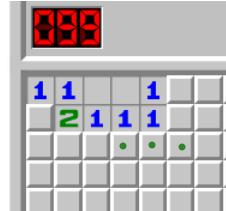
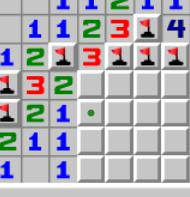
② For other patterns, please refer to the article on basic patterns.
II. Pattern Variations
Pattern variations occur when a pattern doesn't appear in its most basic form. Sometimes, known mines adjacent to a number influence the situation. In these cases, subtract the number of known adjacent mines from the number displayed to determine the effective value, then apply the pattern.
① 1-1 Pattern Variations

The '3' indicated by the orange arrow already has two identified mines adjacent to it. Therefore, its effective value is '1', allowing the 1-1 pattern to be applied.
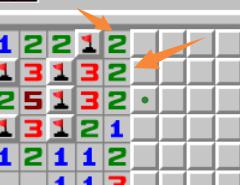
The two '2's indicated by the orange arrows each have one identified mine adjacent. Their effective values are both '1', allowing the 1-1 pattern to be used.
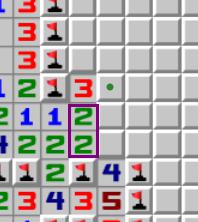
The two '2's within the box effectively form a 1-1 pattern.
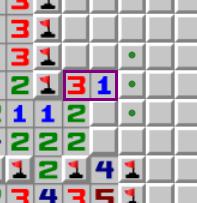
The '3' within the box becomes a '1' after subtracting the two adjacent mines.
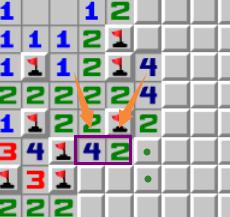
The '4' and '2' within the box become a 1-1 pattern.

The '2' and '3' become a 1-1 pattern.

The '5' and '4' become a 1-1 pattern.
② 1-2-1 Pattern Variations

The '2' indicated by the orange arrow has one identified mine adjacent, making its effective value '1'. The 1-2-1 pattern can be applied.
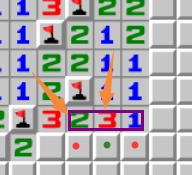
The '2' indicated by the orange arrow has one identified mine adjacent, making its effective value '1'. The '3' also has one identified mine adjacent, making its effective value '2'. Combined with the '1' on the right, this forms a 1-2-1 pattern.
 ,
,
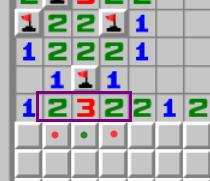
These two examples follow the same logic.
③ 1-2-2-1 Pattern Variations

The '3' indicated by the orange arrow has two identified mines adjacent, making its effective value '1'. The 1-2-2-1 pattern can be applied.

The '2' indicated by the orange arrow has one identified mine adjacent, making its effective value '1'. The 1-2-2-1 pattern can be applied.

The '2-3-3-2' within the purple box has one identified mine adjacent to each number, resulting in an effective 1-2-2-1 pattern.
Game Instructions
Legend: Red dots indicate mines, green dots indicate safe squares.
These examples represent only a small fraction of real-game scenarios. Understanding these patterns and applying them flexibly is crucial.
I. Basic Patterns
① The 1-1 pattern has several variations. Here are a few examples:



② For other patterns, please refer to the article on basic patterns.
II. Pattern Variations
Pattern variations occur when a pattern doesn't appear in its most basic form. Sometimes, known mines adjacent to a number influence the situation. In these cases, subtract the number of known adjacent mines from the number displayed to determine the effective value, then apply the pattern.
① 1-1 Pattern Variations

The '3' indicated by the orange arrow already has two identified mines adjacent to it. Therefore, its effective value is '1', allowing the 1-1 pattern to be applied.

The two '2's indicated by the orange arrows each have one identified mine adjacent. Their effective values are both '1', allowing the 1-1 pattern to be used.

The two '2's within the box effectively form a 1-1 pattern.

The '3' within the box becomes a '1' after subtracting the two adjacent mines.

The '4' and '2' within the box become a 1-1 pattern.

The '2' and '3' become a 1-1 pattern.

The '5' and '4' become a 1-1 pattern.
② 1-2-1 Pattern Variations

The '2' indicated by the orange arrow has one identified mine adjacent, making its effective value '1'. The 1-2-1 pattern can be applied.

The '2' indicated by the orange arrow has one identified mine adjacent, making its effective value '1'. The '3' also has one identified mine adjacent, making its effective value '2'. Combined with the '1' on the right, this forms a 1-2-1 pattern.
 ,
,

These two examples follow the same logic.
③ 1-2-2-1 Pattern Variations

The '3' indicated by the orange arrow has two identified mines adjacent, making its effective value '1'. The 1-2-2-1 pattern can be applied.

The '2' indicated by the orange arrow has one identified mine adjacent, making its effective value '1'. The 1-2-2-1 pattern can be applied.

The '2-3-3-2' within the purple box has one identified mine adjacent to each number, resulting in an effective 1-2-2-1 pattern.
Online HTML Minesweeper Game